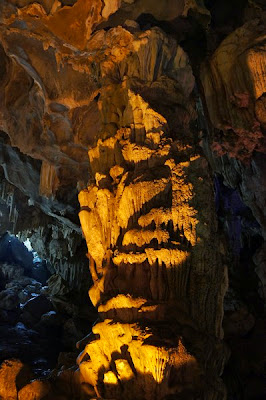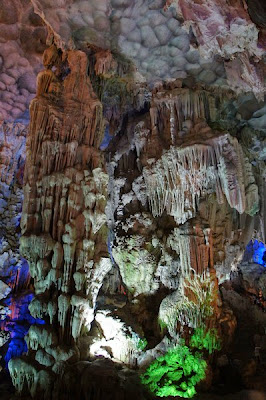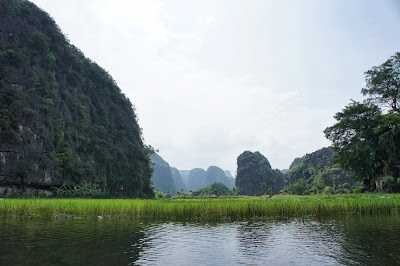Spiritual Balancing & Soul Searching
Mission & Vision
Our MAM Jonker88 Group has organized a series of hairs loose and hands loose holiday trips to natural heritage sites, for exploring the hidden beauty of intangible cultural heritage and tangible cultural property in this region, this is our mission as institutional member of UNESCO-ICOM, this is our social responsibility, as non-profit cultural entity, legally incorporated since 1998, as MAM Museum, together with our stakeholders and smart partnership, non profit cultural Foundations, International Cultural Exchange Foundation, EVA Universe Foundation.
Especially those historic and cultural holistic sites embedded with natural forests, cave , mining , lakes, wetlands, river heritage sites, embedded with scholar rocks and stoned-based caves, like in China, Hanoi, Malaysia are richly found with these natural heritage & cultural property.
We hope you all are enjoying the following natural beauty photos taken…as part of our learning curves & enhancement programs, in fact, is part of our Awakening Course, also as our Enlightening Programs…
To decode the natural mystery and our human, Please close your eyes, opening up your mind…: Are we different and Separate, or We Are The World, We Are One, We Are Inseparable and Indispensable beings….?

Can you see hopes here~?
 |
| 石灰石 Limestone |
石灰岩(CaCO3) Limestone in Cave, 简称灰岩,又叫石灰石,是以方解石为主要成分的碳酸盐岩。石灰岩主要是在浅海的环境下形成的。石灰岩按成因可划分为粒屑石灰岩(流水搬运、沉积形成);生物骨架石灰岩和化学、生物化学石灰岩。
石灰岩是喀斯特地形的主要构成成分,是一種在海、湖盆地中生成的灰色或灰白色沈积岩。石灰岩中常混入白云石、石膏、菱镁矿、黄铁矿、蛋白石、玉髓、石英、海绿石、萤石等。纯石灰岩中混入物一般少于5%。
类型
- 颗粒灰岩:大部分颗粒组分,如内碎屑、骨屑、鲕粒及部分团粒、团块都是经过水流搬运形成,但一部分团粒、团块没有水流作用(异化粒)。
- 砂屑、鲕粒灰岩通常由亮晶胶结,主要堆积于波浪、水流作用很强的开阔滨浅海陆棚区的砂嘴、砂坝、浅滩及潮汐通道等沉积单元。
- 泥晶灰岩:无黏结作用的泥晶方解石组成。可由碳酸盐颗粒磨蚀到最细的产物;也可从水体中化学沉淀出来的细晶(泥晶)沉淀物。属于静水、低能带环境的产物。
- 叠层灰岩:主要由分泌粘液的蓝、绿藻,通过捕集、黏结碳酸盐颗粒形成的岩石。不是靠石化钙藻形成的,又称隐藻粘结灰岩。产出于潮上、潮间低能环境。
- 凝块灰岩:无隐藻纹层的凝块状石灰岩。隐藻凝块体无内部纹层,但具有叠层石的宏观外貌、类似向上生长的构造。与叠层灰岩比,表面粗糙、欠光滑,呈 疙瘩状、皱纹状、麻点状。
- 凝块内部显微组构为不均匀云雾状、海绵状,偶尔显不清楚的同心纹层。有时有少量葛万藻、附枝藻微细丝状体。产出从潮间带至较深的 潮下带。
- 骨架灰岩(生物礁灰岩):一种造骨架的碳酸盐生物构筑体。骨架将碳酸岩沉积物粘在一起,形成固定在海底上的坚硬的具有抗浪性的碳酸盐岩礁。
- 不同的生物骨架灰岩:寒武纪以古杯、钙藻为主;中-晚奥陶世以苔藓虫、层孔虫、板状珊瑚为主;志留纪、泥盆纪以层孔虫、板状珊瑚为主;晚三叠世和晚侏罗世以珊瑚、层孔虫为主;
- 晚白垩世以厚壳蛤类为主;渐新世、上新世、更新世以六射珊瑚为主。骨架灰岩通常在海底形成一个隆起,超出于同期沉积物。隆起块体有点礁、礁丘、环礁、层状礁等。
- 白垩:一种细粒白色疏松多孔的石灰岩,碳酸钙含量大于97%,矿物为低镁方解石,可含少量黏土矿物、细粒石英碎屑,生物组分是颗石藻、少量钙球。生成于温暖海洋环境,深度从几十到几百米。
- 结晶灰岩:由结晶、重结晶(大部分)方解石组成的石灰岩。大部分结晶灰岩是原生石灰岩,经成岩重结晶作用改变原生颗粒、生物黏结组分形成。
- 结晶灰岩也有原生的,如大陆地表泉水、岩洞或河水蒸发形成的石灰华、泉华。石灰华是一种致密的带状钙质沉淀物,如钟乳石、石笋,发育有从溶液中依次沉淀的方解石或文石晶体所组成的皮壳状纹层。
- 多产出于岩洞表面。钙泉华指地表上海绵状多孔疏松的方解石或文石晶体沉淀物,呈树枝状、放射状、半球状等,内部常保留有植物茎、叶的痕迹。产出于温泉、裂隙水出露的地表。
- 钙结岩:一种发育于干旱、半干旱地区土壤和细砂中的富石灰质沉积物,呈同心环带的似枕状体。
 |
| 石灰石 Limestone |
沉积岩是在地表不太深的地方,将其他岩石的风化产物和一些火山喷发物,经过水流或冰川的搬运、沉积、成岩作用形成的岩石。
在地球地表,有70%的岩石是沉积岩,但如果从地球表面到16公里深的整个岩石圈算,沉积岩只占5%,因此沉积岩是构成地壳表层的主要岩石。
沉积岩主要包括有石灰岩、砂岩、页岩等。沉积岩中所含有的矿产极为丰富,占全部世界矿产蕴藏量的80%。
沉积岩特征是有层理,某些含有动植物化石,所以可以断定其地质年代。相較於火成岩及变质岩,沉積岩中的化石所受破壞較少,也較易完整保存,因此對考古學來說是十分重要的研究目標。
成因
风化的岩石颗粒,经大气、水流,到一定地点沉积下来,受到高压的成岩作用,逐渐形成岩石。沉积岩保留了许多地球的历史信息,包括有古代动植物化石,沉积岩的层理有地球气候环境变化的信息。
构造
层理构造
层理构造是由沉积物的成分或粒徑大小的结构沿垂直于沉积物表面(层面)方向及側向延伸变化而显示出来的一种层状构造。层理构造是与要岩浆岩、变质岩区别的重要标志。常见的有:
- 水平层理:由一系列与层面平行的细层组成的层理;一般形成于平静的或微弱流动的水环境中。
- 斜理层理:由一系列与层面斜交的细层组成的层理;一般是在单向水流(或风)的作用下形成的,常见于河床沉积物中。
- 交错层理:有些斜层理与原来生成的斜层理呈一定角度相交,相互交错(切蝕)而形成的。
- 递变层理:同一层内碎屑颗粒粒径向上逐渐变细;它的形成常常是因沉积作用发生在运动的水介质中,其动力由强逐渐减弱。
层面构造
- 波痕:在还没有固结的沉积层面上,由于流水、风或波浪的作用形成的波浪起伏的表面,经过成岩作用保存下来。
- 泥裂:没有固结的沉积物露出水面干涸时,经过脱水收缩干裂而形成的裂缝。
分类
碎屑沉积岩
是从其他岩石的碎屑沉积形成的,包括有长石,闪石,火山喷出物,黏土,以及变质岩的碎屑,碎屑的大小不同形成的岩石也不同,形成页岩的碎屑小于0.0039 mm,形成粉砂岩的碎屑在0.0039 至 0.0625 mm 之间,形成砂岩的碎屑则有0.0625 到 2 mm之間,形成砾岩的碎屑则有2 到 256 mm。
沉积岩的分类不仅根据其形成颗粒的大小,还要考虑到组成颗粒的化学成分,形成的条件等因素。颗粒形成的条件,是被冰、水、温度变化将岩石碎裂,也有是由于化学作用,如淋溶再析出等。在搬运过程中,颗粒体积进一步变小,最终在一个新地点沉积成岩。
生物沉积岩
化学沉积岩
Sedimentary rocks are types of rock that are formed by the deposition of material at the Earth's surface and within bodies of water.
Sedimentation is the collective name for processes that cause mineral and/or organic particles (detritus) to settle and accumulate or minerals to precipitate from a solution.
Particles that form a sedimentary rock by accumulating are called sediment. Before being deposited, sediment was formed by weathering and erosion in a source area, and then transported to the place of deposition by water, wind, ice, mass movement or glaciers which are called agents of denudation.
The sedimentary rock cover of the continents of the Earth's crust is extensive, but the total contribution of sedimentary rocks is estimated to be only 8% of the total volume of the crust.
Sedimentary rocks are only a thin veneer over a crust consisting mainly of igneous and metamorphic rocks. Sedimentary rocks are deposited in layers as strata, forming a structure called bedding.
The study of sedimentary rocks and rock strata provides information about the subsurface that is useful for civil engineering, for example in the construction of roads, houses, tunnels, canals or other constructions. Sedimentary rocks are also important sources of natural resources like coal, fossil fuels, drinking water or ores.
The study of the sequence of sedimentary rock strata is the main source for scientific knowledge about the Earth's history, including palaeogeography, paleoclimatology and the history of life.
The scientific discipline that studies the properties and origin of sedimentary rocks is called sedimentology.
Sedimentology is both part of geology and physical geography and overlaps partly with other disciplines in the Earth sciences, such as pedology, geomorphology, geochemistry or structural geology.
Cave or cavern is a natural underground space large enough for a human to enter. Caves form naturally by the weathering of rock and often extend deep underground. The word "cave" can also refer to much smaller openings such as sea caves, rock shelters, and grottos.
It is estimated that the maximum depth of the cave cannot be more than 3,000 meters: deeper caves are crushed by the weight of overlying rock.
For karst caves the maximum depth is determined on the basis of karstovaniya (the lower limit of karst marking processes, coinciding with the base sequences limestone), which may be lower than the basis erosion due to the presence of siphon channels..
Speleology is the science of exploration and study of all aspects of caves and the environment that surrounds the caves. Exploring a cave for recreation or science may be called caving, potholing, or, in Canada and the United States, spelunking (see caving).
Types and formation
The formation and development of caves is known as speleogenesis. Caves are formed by various geologic processes and can be variable sizes. These may involve a combination of chemical processes, erosion from water, tectonic forces, microorganisms, pressure, atmospheric influences, and even digging.
Most caves are formed in limestone by dissolution.
Click here to view more photos about crystal & precious stone:
Dr. Fish
Look at that Dr. Fish kissing your legs! The moment you feel these beings kissing and caring…sounds these beings better understanding our spiritual needs…..Love & Care.
They strike a balancing to rebalancing you spiritually and physically, and rejuvenate You, just by their Passion, Love & Caring… kissing…
Are We better than these beings, we Human are also one of the beings, why can’t we perform better to love our surroundings, love your parents, care your family members, brothers, colleagues, classmates, roommates, friends, and other millions beings living together with us, gifted by the God…?
If you really believe, you follow the commandments. Love your neighbours as yourself…. Love Is God, God Is Love…… Dr. Fish is also the God who kiss and care for your legs!,;
Also those preserved humanly the forests and mountains, lakes, rivers, flowers and plants, and those beings, all lived in one, Oneness….
Why can’t we follow the commandments of Love Your Neighbour As Yourself, Love those who needs love and help, as your love your God, God will do the same to love and care your beloved one….!
In Matthew, when asked "which is the great commandment in the law?", the Bible reports that Jesus answered, "Thou shalt love the Lord thy God with all thy heart, and with all thy soul, and with all thy mind", before also referring to a second commandment, "Thou shalt love thy neighbour as thyself".
Brotherly love in the biblical sense is an extension of the natural affection associated with near kin, toward the greater community of fellow believers, that goes beyond the mere duty in Leviticus 19:18 to "love thy neighbour as thyself", and shows itself as "unfeigned love" from a "pure heart", that extends an unconditional hand of friendship that loves when not loved back, that gives without getting, and that ever looks for what is best in others
In the New Testament
The theme of love is the key element of Johannine writings: "God loves Christ, Christ loves God, God loves humanity, and Christians love God through their love for Christ".
Christians are bound together through their mutual love, which is a reflection of their love for Christ.
The word "love" appears 57 times in the Gospel of John, more often than in the other three gospels combined. Additionally, it appears 46 times in the First Epistle of John.
In the Gospel of John, love for Christ results in the following of his commandments. In John 14:15, Jesus states, "If you love me, you will keep my commandments." and John 14:23 reconfirms that: "If a man love me, he will keep my word".
The dual aspect to the above is Jesus' commandment to his followers to love one another.
In John 13:34-35, during the Last Supper, after the departure of Judas, and just before the start of the Farewell Discourse, Jesus gives a new commandment to his eleven remaining disciples: "Love one another; as I have loved you" and states that: "By this shall all men know that you are my disciples."
Outside of Johannine literature, the earliest New Testament reference to the love for Christ is 1 Corinthians 16:22—"If any man loveth not the Lord, let him be anathema".
This is our MAM Jonker88 Group’s Mission & Vision, as an institutional member of UNESCO-ICOM ( ICOM No: 29766), also served as International Committee members of UNESCO-ICOM Conservation, CECA, CIMAM, CIMASET, ICMAT…
This is our Mission to preserve, to promote and to advocate those holistic sites, historic sites of tangible cultural property and intangible cultural heritage, natural heritage, biodiversity of our human living environment.
This is the main reason Our cultural group, non profit cultural entity, continually to present to our Peace Lover, Cultural Conservators, World Citizens, International Tourists, domestic tourists, students, young….Irrespective of Who, Whom, Where You From, irrespectively of your nationality cultural or ethics, personal identity, social status, colour of skin, irrespectively of your religions and personal believes...
If you are one of the beings in this universe, hence this Universal Heritage is Each and Every one shall play in preserving our endangered species and historic sites, within your ways and means…This is our Common Survival Philosophy, As We Are One, We Are The World, We All In One, Oneness!
Messages by Management of MAM Jonker88 Group
**洗脚礼是某些基督教教派所举行的宗教仪式。最初的由来与当时犹太人的风俗有关,而在教会历史上也曾有许多教派在正式典礼中实行过。
传至今日,大多数地区已没有像当时的犹太人一样,有为客人洗去脚上泥土的必要。
最重要的是,虽然洗脚礼最初是由耶稣而来,他却未曾吩咐过门徒以后要行礼如仪,像行洗礼或圣餐礼一样。
因此在各教派中,虽然有时也采取象征式的作法,如天主教之教宗在其所定的受难节活动时,会为大主教们洗脚,但这些均只是代表性的,并不把洗脚礼定位不可或缺的圣礼之一,而只是着重效法耶稣为门徒洗脚所彰显的谦卑与服事的精神而已。
洗脚礼的由来~
- 主耶稣亲自设立 - 主耶稣在使徒们吃最后晚餐之时,他知道神所定的日子到了,就站起来,把水倒在盆里洗徒们的脚,并用自己所束的手帕搽干(约翰福音13:1-5)。犹太人洗脚的风俗,是由仆人为主人或客人洗脚。而主耶稣虽是主人、老师,却亲自为门徒倒水洗脚,所表明的意义,就绝不是风俗习惯而已。
- 主命令门徒要照样去行 - 当主为门徒洗完脚后,就问说“我向你们所作的,你们明白吗?”,门徒虽然尚未完全明白,主却立刻教导他们说“我给你们做了榜样叫你们照着我向你们做的去做”。而且应许说“你们即知道这事,若是去行就有福了”,可见主重视这件事。
Click here to view more photos about crystal & precious stone:






































































































































































Thank you so much for share such a wonderful post.I like the way of writing and i bookmarked this post for my next work.I am waiting for your next post.custom writing service
ReplyDelete